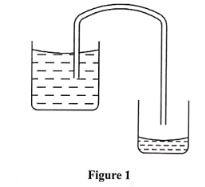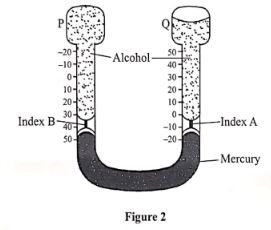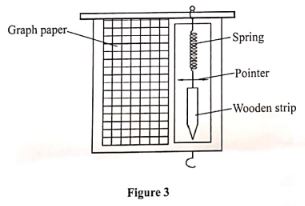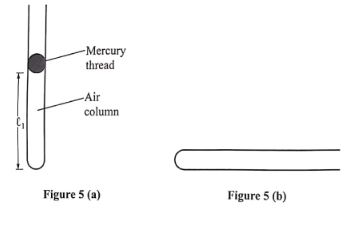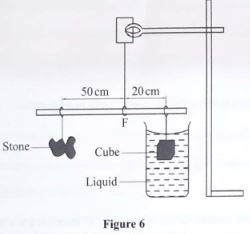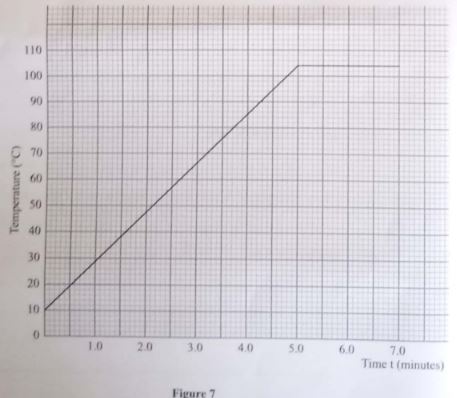SECTION A (25 marks)
Answer all the questions in this section in the spaces provided.
- State what is meant by "Area". (1 mark)
- State the SI unit of area. (1 mark)
- Explain why water in a glass tube forms a concave meniscus. (2 marks)
- Figure 1 shows how water is drawn from a large tank into a low lying container using a rubber tube.
Explain how the process takes place. (2 marks) - State how a piece of paper can be used to demonstrate that matter is made of tiny particles. (1 mark)
- Figure 2 shows Six's maximum and minimum thermometer.
Explain how increase in temperature causes index A to move upwards. (2 marks) - State the difference between heat and temperature. (2 marks)
- State two factors that affect the stability of a cylindrical container. (2 marks)
- Figure 3 shows a set up in which a spring with a pointer is attached to a wooden strip that has a hanging hook. A graph paper is fixed along the strip to be used to calibrate the spring.
A mass of 100 g is provided. Explain how the spring balance can be calibrated. (3 marks) - Water enters a pipe at a velocity V, at a point where the cross-sectional area is A,. It leaves the pipe at a velocity V2 at a point where the cross sectional area is A2. Show that A, V1 = A2V2. (3 marks)
- Sketch the displacement-time graph for a body moving with decreasing velocity. (1 mark)
- Figure 4 shows a graph of force against time when a tennis ball is hit.
Determine the mass of the tennis ball whose velocity is 60 ms-1. (Assume the ball is stationary before it is hit). (3 marks) - State the energy transformations that take place as a pendulum bob swings. (1 mark)
- When determining the specific latent heat of fusion of ice by electrical method, other than mass, voltage and current, state one other measurement that should be taken. (1 mark)
SECTION B (55 marks)
Answer all the questions in this section in the spaces provided.
-
- State Boyle's law. (1 mark)
- Figure 5 (a) shows a column of air of length 6cm trapped by a mercury thread in a tube. Figure 5 (b) shows the same tube in a horizontal position.
- Draw the mercury thread in Figure 5 (b). (2 marks)
- Explain why the thread appears as in 14(b)(i). (2 marks)
-
- State what is meant by "absolute zero temperature". (1 mark)
- A balloon contains hydrogen gas at a temperature of 2 °C and a pressure of 6 mmHg. Determine the pressure in the balloon when the temperature is raised to 80°C. (3 marks)
-
- State two ways in which the centripetal force acting on a body of mass M can be reduced. (2 marks)
- A stone of mass 0.5 kg tied to a string is whirled in a vertical plane along a circular path of radius 2m and that its frequency is 2 cycles per second. (π-3.142)
- Determine the:
- velocity of the stone (3 marks)
- tension in the string when the stone is at the top most part of the circular path (3 marks)
- State with a reason how the tension in the string changes as the stone gets to the bottom of the circular path. (2 marks)
- Determine the:
-
- Figure 6 shows a cube of mass 2 kg and sides 5 cm fully immersed in a liquid of density 0.8 gem3. The cube is balanced by a stone of mass M
Given that the gravitational field strength, g, is 10Nm 2, determine the:- upthrust acting on the cube (3 marks)
- apparent weight of the cube (3 marks)
- weight of the stone (3 marks)
- A block of mass 500 g floats in water. Determine the volume of the block under the water. (density of water is 1 gem). (3 marks)
- Figure 6 shows a cube of mass 2 kg and sides 5 cm fully immersed in a liquid of density 0.8 gem3. The cube is balanced by a stone of mass M
-
- State two factors that affect the boiling point of a substance. (2 marks)
- A well lagged calorimeter contains a liquid of mass 200g at a temperature of 10°C. An electric heater rated 80 W is used to heat the liquid. Figure 7 shows a graph of temperature against time for the liquid.
From the graph, determine the:- boiling point of the liquid (1 mark)
- quantity of heat given out by the heater between time t = 1 minute and time 1=4.5 minutes (3 marks)
- Based on (b)(ii), determine the:
- temperature change between the time t- 1 minute and time t-4.5 minutes (1 mark)
- specific heat capacity of the liquid (3 marks)
- 2g of vapour was collected from the liquid between times t=5.4 minutes and t=6.3 minutes. Determine the specific latent heat of vaporisation of the liquid. (3 marks)
-
- A weighing balance placed on the floor of a lift is used to measure the weight of a body of mass 80 kg. Determine the reading on the balance when the lift moves upwards: (acceleration due to gravity g is 10ms 2)
- with uniform velocity (3marks)
- with an acceleration of 3 ms-2 (3 marks)
- Explain why a person standing on a boat is likely to fall into the water when attempting to jump to the shore. (3 marks)
- A box is moved 30m along a surface whose frictional force is 1000 N with uniform velocity. Determine the work done against friction. (2 marks)
- A weighing balance placed on the floor of a lift is used to measure the weight of a body of mass 80 kg. Determine the reading on the balance when the lift moves upwards: (acceleration due to gravity g is 10ms 2)
MARKING SCHEME
SECTION A (25 MARKS)
| 1. | (a) Area is a measure of the extent of a surface. (b) m2 (metre squared) |
1 1 |
| 2. | The adhesive forces between water molecules and glass are higher √ than cohesive forces √ in water molecules. | 2 |
| 3. | Remove air from the tube to create a partial vacuum/fill the tube with 2 water, (√) the pressure difference √ between the two ends makes the water to flow. | 2 |
| 4. | The piece paper can be cut into tiny pieces. | 1 |
| 5. | Increase in temperature causes the alcohol in P to expand pushing mercury up on the right side of the u tube. The mercury pushes index A up. | 2 |
| 6. | Heat is a form of energy while temperature is the degree of hotness | 2 |
| 7 |
|
2 |
| 8. |
|
3 |
| 9. | Volume inflow = A1V1 Volume outflow=A2V2 Since the water is incompressible.√ Volume inflow = Volume outflow. A1V1= A2V2 |
|
| 10. | 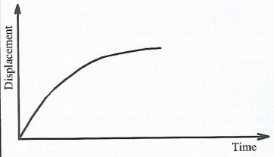 |
|
| 11. | Ft = mV Ft = area under curve = ½ × 0.5 × 500 = 125 125 = m × 60 m = 2.0833 kg |
|
| 12 | Potential → Kinetic → Potential | |
| 13. | Time | |
| 14. |
|
1 2 2 1 3 |
| 15. |
|
|
| 16 |
|
|
| 17. |
|
|
| 18. |
|
Download PHYSICS Paper 1 Questions and Answers - KCSE 2022 Past Papers.
Tap Here to Download for 50/-
Get on WhatsApp for 50/-
Why download?
- ✔ To read offline at any time.
- ✔ To Print at your convenience
- ✔ Share Easily with Friends / Students

